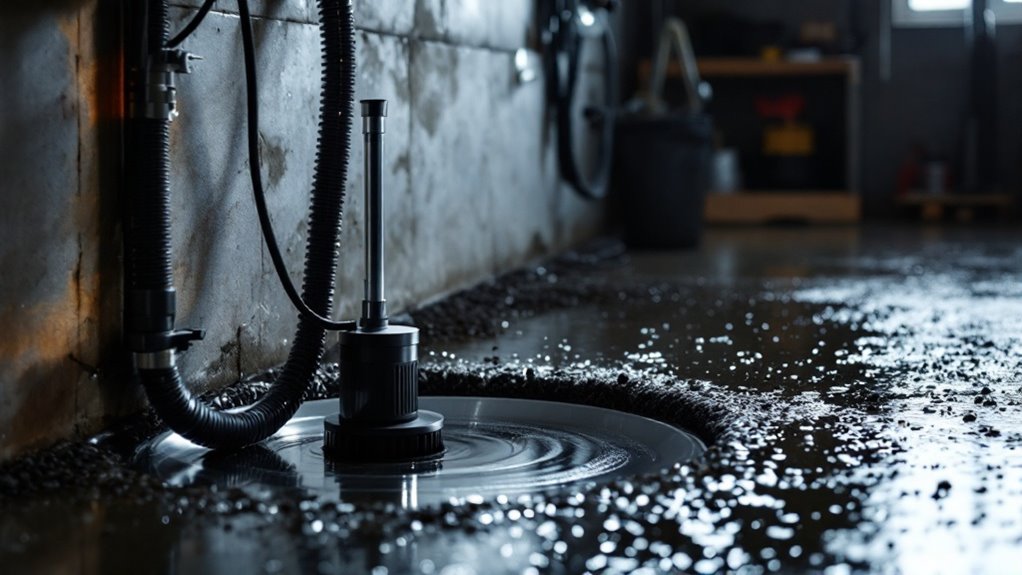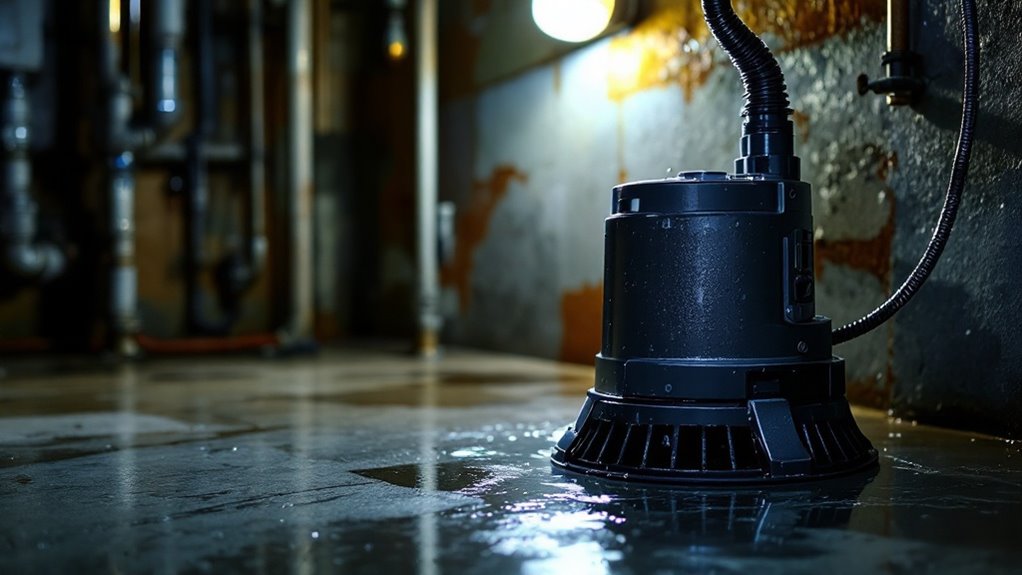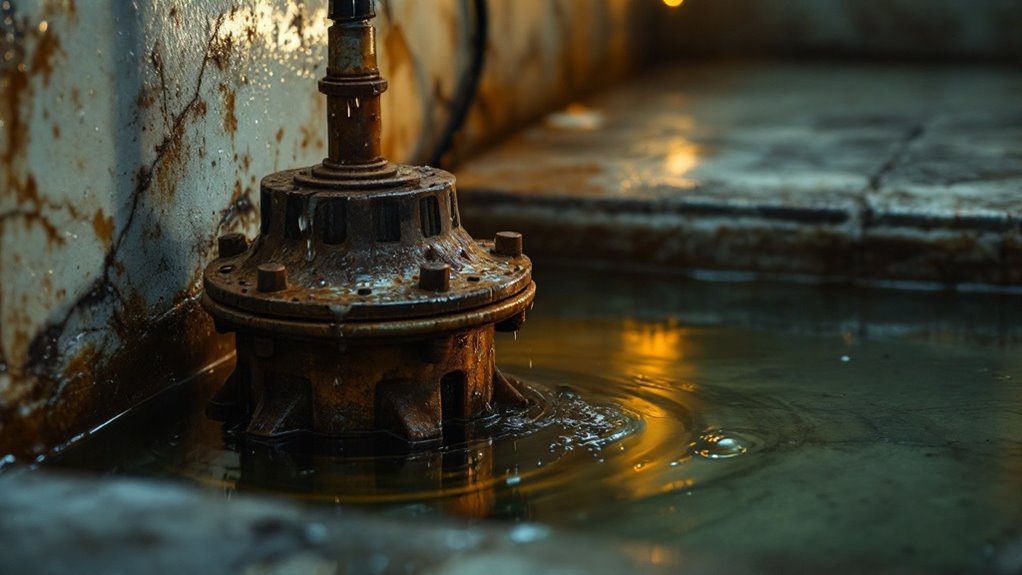When it comes to protecting your home from water damage, sump pumps are essential. They kick in automatically when water levels rise, preventing flooding and mold growth. But with different types available, how do you know which is best for your space? Plus, understanding the key components and maintenance can make a significant difference. Let’s investigate what you need to know to guarantee your home stays dry and safe.
Key Takeaways
- Sump pumps prevent water accumulation in basements, protecting against water damage and mold growth.
- Choose between submersible and pedestal pumps based on basement size and water volume.
- Regular maintenance includes monthly checks, cleaning, and testing the float switch for proper operation.
- Watch for signs of wear such as unusual noises or frequent cycling, indicating a need for replacement.
- Consult a professional for expert assessments and installation to ensure optimal performance and prevent future issues.
What Is a Sump Pump and How Does It Work?

A sump pump is an important device designed to prevent water accumulation in basements or crawl spaces. It works by collecting excess water that seeps in from the ground or through pipes. When the water level rises in the sump basin, the pump activates automatically. You’ll find that most sump pumps use a float switch to detect the water level, guaranteeing efficient operation. Once activated, the pump pushes the water through a discharge pipe, directing it away from your home’s foundation. This process helps protect your property from water damage, mold growth, and structural issues. Regular maintenance is vital to guarantee your sump pump operates effectively when you need it most, keeping your home dry and safe. Additionally, having expert water damage restoration services on speed dial can be crucial in case of an emergency.
Types of Sump Pumps: Which One Is Right for You?
When choosing the right sump pump for your home, what factors should you consider? There are mainly two types: submersible and pedestal pumps. Submersible pumps sit underwater in the sump basin, making them quieter and less prone to damage. Pedestal pumps, on the other hand, are mounted above the sump and are easier to access for maintenance.
| Type | Advantages |
|---|---|
| Submersible | Quieter, space-saving, efficient |
| Pedestal | Easier maintenance, longer lifespan |
Consider your specific needs, like your basement’s size and the amount of water you expect. Additionally, having knowledge of emergency plumbing services can aid in a quick response if your sump pump fails. Evaluate power options too—electric vs. battery backup can impact performance during power outages. Choose wisely to protect your home!
Key Components of a Sump Pump System

Choosing the right sump pump is just the first step in protecting your home from water damage. To guarantee your system works effectively, you need to understand its key components. The sump pit collects water, serving as the reservoir. The pump itself moves water from the pit to the discharge pipe, where it’s expelled away from your foundation. The float switch activates the pump when water levels rise, while the check valve prevents backflow. It’s additionally important to have a power source—consider a battery backup for power outages. Finally, a proper discharge line is essential to direct water safely away from your home. Regular inspection of drainage systems helps ensure that your sump pump can operate without obstruction. Knowing these components helps you maintain an effective sump pump system.
Installation Process: Setting Up Your Sump Pump
Setting up your sump pump starts with choosing the right location to guarantee effective water drainage. You’ll need specific tools and materials for the installation, so gather everything before you begin. Let’s walk through the step-by-step process to get your sump pump up and running efficiently.
Site Selection Guidelines
Selecting the right site for your sump pump is crucial for its effectiveness and longevity. Ideally, you want to place it in the lowest part of your basement or crawl space, where water naturally collects. Make sure there’s enough space around the pump for maintenance and airflow. Avoid placing it near walls or obstructions that could restrict access. Check for any nearby water sources, like gutters or downspouts, and position the pump away from them to prevent overwhelming it. Furthermore, consider the proximity to a power source, as your pump needs electricity to operate. Finally, verify the area is dry and free from debris, which can affect the pump’s performance. Making these considerations will improve your sump pump’s reliability.
Required Tools and Materials
To successfully install your sump pump, you’ll need a few vital tools and materials. First, gather a shovel for digging the sump pit, a level to guarantee proper alignment, and a tape measure for accurate dimensions. You’ll as well need a drill with a masonry bit to create any necessary holes. Furthermore, have PVC pipe and fittings on hand for drainage, along with a check valve to prevent backflow. Don’t forget a power source, as many sump pumps require electricity. Safety gear like gloves and goggles is fundamental, too, to protect yourself during the installation. With these tools and materials ready, you’ll set yourself up for a smoother installation process.
Step-by-Step Installation Process
Installing a sump pump involves a series of straightforward steps that can help protect your home from flooding. Follow these steps for a successful installation:
- Choose a Location: Select a spot in your basement or crawl space, ideally near a floor drain.
- Dig the Pit: Excavate a hole about 2 feet deep and 18 inches wide for the sump pit.
- Install the Pump: Place the sump pump in the pit, making sure it sits level.
- Connect the Discharge Pipe: Attach the discharge pipe to direct water away from your foundation.
Once you’ve completed these steps, plug in the pump and test it to verify it’s working correctly. Now, you’re ready to safeguard your home against water damage!
Maintenance Tips to Keep Your Sump Pump Running Smoothly
Keeping your sump pump in top shape is crucial for preventing water damage and guaranteeing it operates when you need it most. Start by checking your sump pump regularly, at least once a month. Inspect the power source and verify it’s plugged in and functioning. Clean the pump and the pit to remove any debris that could cause clogs. Test the float switch by pouring water into the pit to see if it activates. During heavy rain seasons, consider running a manual test to confirm it’s working properly. Finally, replace the battery in battery-operated pumps every few years. By following these maintenance tips, you’ll help extend your sump pump’s lifespan and keep your home safe from unwanted water intrusion.
Signs You Need to Replace Your Sump Pump

If your sump pump is cycling on and off frequently, it might be time for a replacement. Look for visible signs of rust or corrosion, as these can indicate wear and tear. Furthermore, any unusual noises during operation should raise a red flag that something isn’t right.
Frequent Pump Cycling
Frequent pump cycling can signal that your sump pump is struggling to keep up with its workload, which may indicate it’s time for a replacement. If you notice this issue, pay attention to the following signs:
- Increased cycling frequency: Your pump shouldn’t activate every few minutes.
- Short cycling: If it runs for only a minute or two before shutting off, it’s a concern.
- Noisy operation: Unusual sounds can mean it’s working harder than it should.
- Inconsistent performance: If the pump doesn’t remove water effectively, it’s time to evaluate a new unit.
Recognizing these signs early can help prevent water damage and save you more significant costs down the line.
Visible Rust or Corrosion
Visible rust or corrosion on your sump pump is a clear sign that it’s time for a replacement. These signs indicate that your pump is deteriorating, which can lead to failure when you need it most. Rust and corrosion compromise the pump’s structural integrity, making it less effective at removing water. If you see any discoloration or flaking on the metal components, take it seriously. Even minor rust can grow and spread, leading to more significant issues down the line. Waiting too long to address this problem can result in costly water damage to your home. Don’t ignore these warning signs; replacing your sump pump now can save you from headaches and expenses later.
Unusual Noises During Operation
Have you noticed your sump pump making strange noises during operation? These unusual sounds can indicate that it’s time for a replacement. Ignoring them may lead to bigger problems down the line. Here are some common noises to watch for:
- Gurgling – This could mean a clogged discharge line or a problem with the float switch.
- Banging – Often a sign of loose components or water hammer, which can be damaging.
- Humming – If your pump is humming but not pumping, it may be stuck or have a motor issue.
- Squealing – This might indicate worn bearings or a failing motor.
If you hear any of these, it’s wise to consult a professional before water damage occurs.
Conclusion
To summarize, sump pumps are essential for protecting your home from water damage. Did you know that nearly 60% of homes in the U.S. have some level of moisture in their basements? By understanding how sump pumps work and choosing the right one for your space, you can safeguard your property effectively. Regular maintenance and being aware of replacement signs will keep your sump pump running smoothly, so you can enjoy peace of mind during heavy rains.
